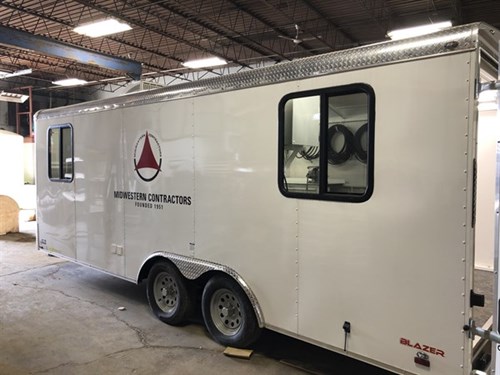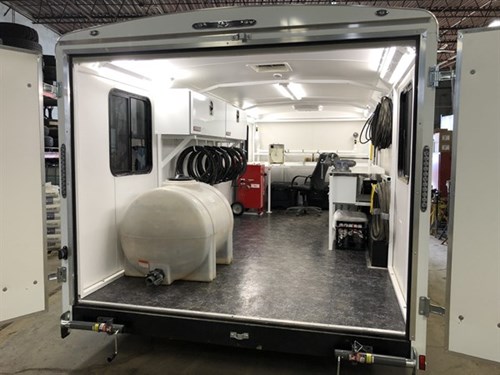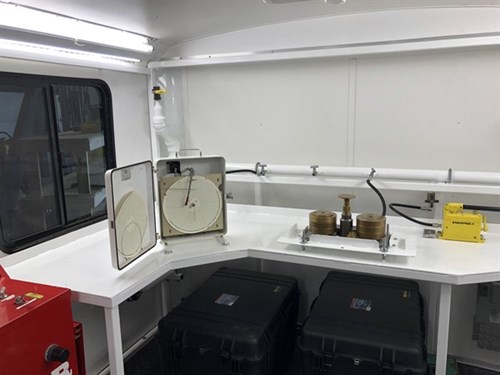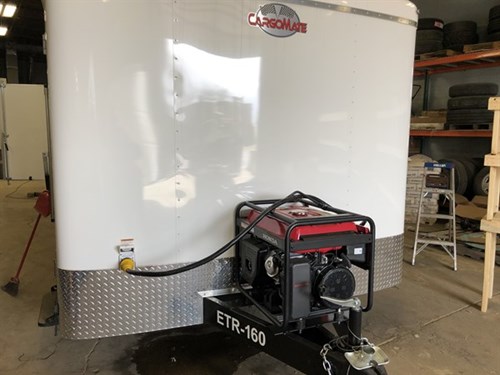Hydrostatic Testing
When pipelines are built, relocated or repaired, when station piping is modifiied, but before the pipe assemblies or segments are placed into service a test must be done to determine the strength and leak resistance of the pipe assembly. Pipelines operate at Maximum Allowable Operating Pressure or (MAOP). Normally a hydrostatic test is conducted with a pressure that is 1.25 to 1.5 x MAOP. This builds in a margin of safety as product is moved through the pipe under normal operating conditions.

Test trailer nearing completion in Midwestern Contractor's shop
There are many reasons why hydrostatic testing is preferred over air or nitrogen testing. The website https://www.whatispiping.com shows the comparison between Hydrostatic tests and air tests:
|
Hydrostatic Testing
|
Pneumatic Testing
|
|
Test pressure is normally 30% higher than the design pressure
|
Test pressure is normally 10% higher than the design pressure
|
|
Recommended for high pressure applications
|
Recommended only for low pressure applications
|
|
Test media (Water) used is not compressible by pressure application
|
Test media (Air) used is compressible by pressure application
|
|
Energy stored per unit volume of water under test pressure is very negligible
|
Energy stored per unit volume of compressed air under test pressure is very high
|
|
Needs thorough cleaning after test to
eliminate moisture especially for service which are reactive to moisture / fluids
|
Easy to clean after testing
|
|
Pressure Relief devices are recommended to control sudden increase in pressure during testing
|
Pressure relief devices are must during test to ensure no over pressurisation
|
|
Chances of equipment/ Pipe / test apparatus
failures are very low
|
Chances of equipment/ Pipe / test apparatus
failures are high
|
|
Weight of equipment along with test medium as
water is high hence special attention should be given to floor and supporting arrangements
|
Weight of equipment with test medium
as air is comparatively less
|
|
Needs verification and examination of joints and connections before testing
|
Needs very careful checking of weld joints thoroughly before testing
|
|
Test media can be reused or transferred to other place after testing
|
Test media can not be reused or transferred to other place after testing
|
|
Skilled and semi skilled personnel can carry out the test
|
Needs involvement of senior experienced staff to monitor the test.
|
|
Recommended where large volumes are to be tested at same time (example pipe lines )
|
If pipe lines are tested should be done with small segmental lengths at a time.
|
|
Damages made by failures are less compared to failures in pneumatic testing
|
Damages made by failures in testing are very huge and extensive
|
|
Hydrotest is a regular day to day practice and safe procedure and it can be followed in any work site
|
Needs special attention and safety precautions
|
|
Pressure changes finite amount by infinitesimal change in volume |
Pressure change proportional to volume change |
From a safety standpoint the energy stored per unit of volume with a hydrostatic test is negligible because water is virtually incompressible. Air on the other hand is compressible and stores energy. A failure with an air or nitrogen test would be catastrophic, but with water dramatically less so.

Interior view of trailer
A hydrostatic test can take days. The pipe must be filled with water, pumps apply pressure to the fluid filled pipe. When the test pressure is reached the recording process begins. If the pressure is maintained within the specified range for a period of hours then the test is certified and logged. After the test is completed the water must be discharged. There are many instances where the water cannot be simply discharged on the ground. Instead various methods are used for disposal including process sewers, sanitary sewers, filters of various types. After the water is disposed of the pipe must be dried to a specified dew point level. From this description is is easy to see that a typical hydrotest involves many people and can take days to set up, conduct, record and dewater.

Test bench
Since inspectors and operators are monitoring equipment for hours at a time, the environment for pressuring up and recording data should be one that is safe and comfortable. Midwestern Contractors designed a built several test trailers to accomplish this task. The trailer illustrated in this article is self contained. It has it's own air conditioning, heating, and power. Test equipment benches are large with plenty of room for recorders and computers. All fittings are neatly organized in secure cabinets. Valves and hoses are pre-tested and available for any type of test. A 100 gallon water tank is on hand for final pressurizing.

Auxillary power
Our customers and their inpectors have responded positively to our mobile test facilities. They provide a safe enviroment for our employees, and by demonstrating that we care about this process, their pride of workmanship is enhanced.
Our drive for continuous improvement shows in these mobile test trailers. On the job, especially in foul weather they have paid big benefits by allowing our employees to focus on the hydrostatic test for testrs on these very important customer assets.
